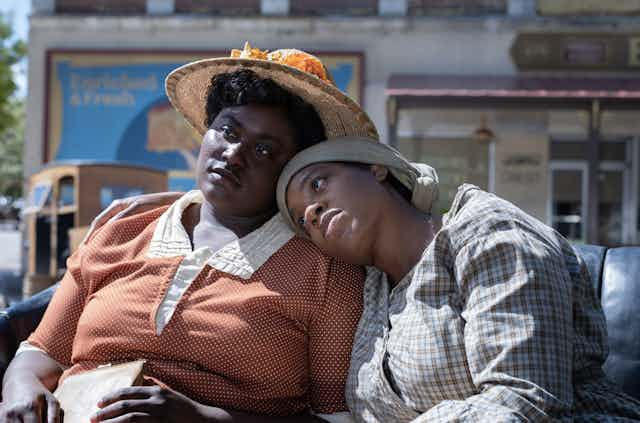Warning: this article includes spoilers.
Alice Walker’s novel, The Color Purple, tells the story of Celie, an African-American woman living in rural Georgia, over 40 years as she survives and heals following abuse.
I research black feminism in contemporary fiction, so I was intrigued by how director Blitz Bazawule would adapt Walker’s novel into a musical film while retaining the intimate exploration of black women’s agency the book is famed for.
Walker’s novel comprises personal and tender letters from Celie (played at different ages by Phylicia Pearl Mpasi and Fantasia Barrino) to God, and later to her sister Nettie (Halle Bailey/Ciara). The film moves away from this solely first-person perspective, creating space for the more spirited, strong-willed characters Nettie and Sofia (Danielle Brooks) to tell their story. This means that Celie’s story takes more of a backseat in the first part of the film.
But what the adaptation loses in its move away from a single protagonist, it makes up for with song. When Celie does find her voice, gradually taking up more space, we truly feel her pain, refusal and eventual joy.
There was a risk that contemporary viewers might interpret the rural, majority-black communities depicted in the film as living comfortable lives. Particularly through scenes that show Harpo’s (Corey Hawkins) affluent juke joint and the local lively jazz scene. But an opening song featuring domestic and field labourers shows how the characters found community despite the harsh realities surrounding them.

Racism rears its ugly head later on, in a brutal scene in which Sofia is beaten and jailed for refusing to become a maid to the mayor’s wife. This will strike a chord with viewers because it speaks to police brutality today.
Some might recognise Whoopi Goldberg’s cameo as Celie’s midwife (Goldberg played Celie in the 1985 film), a moment that shows the lineage between the adaptations and speaks to black women’s care practices, passed down through generations.
Sisterhood and solidarity
Celie suffers sexual abuse at the hands of her father and is married off at a young age to a violent husband known only as “Mister” (Colman Domingo). She doesn’t know her worth until she meets the glamorous, self-assured blues singer Shug Avery.
Shug, whose previous relationship with Celie’s husband ended because she refused to be tied down, forms a deep connection with Celie. While their intimate moments can be read more explicitly as queer in Walker’s novel, the tenderness between the women is clear. The moment they give in to desire is subtle, perhaps speaking to the clandestine way that same-sex love was expressed in this era.

Through Shug, Celie finds her own beauty and inner strength and regains her faith. This echoes the line from the book that gives the novel its title: “I think it pisses God off if you walk by the colour purple in a field somewhere and don’t notice it.”
Similarly to Walker’s novel, black female sisterhood and solidarity rings true in the film. What differs is the space Sofia is given. In Bazawule’s film, she takes centre stage as a flawed yet complex character, strong (physically) and prone to violence, but openly vulnerable, complicating the “strong black woman” trope.
However, less progressive is Shug’s casting as a light-skinned black woman, Taraji P. Henson. Though Henson’s performance is captivating, this casting decision contradicts Walker’s explicitly dark-skinned description of Shug and misses an opportunity to challenge colourism in the film industry.
Black masculinity in The Color Purple
The Color Purple centres black women’s voices and challenges patriarchy and abuse in black communities. Yet, according to black feminist movements, we can challenge abusive men and also understand that patriarchy harms them too.
Films and TV shows such as Moonlight (2017) and Top Boy (2011-2023) have prompted questions about how both black and queer masculinity are represented on screen. I wondered how Bazawule would stay true to Walker’s story and also portray black men with complexity.

While Mister and Alfonso are indeed brutal characters, Mister tries to redeem himself at the end by selling his land to help Nettie return to the US following her time as a missionary in Africa. This differs from the book, where Nettie’s return is sudden.
Although Celie doesn’t openly forgive him, this is a moment of closure sealed with gospel-inspired music that echoes the self-belief, faith and community Celie finds at the end of Walker’s novel.
The dance sequences bring joy to the film. But they bring problems too. One scene depicts Nettie’s travels to Africa as a “return” to a place where “we were kings and queens”. This makes Africa, a diverse continent, seem like a homogeneous place, acting only as a backdrop for African-Americans to understand their blackness.
Nettie’s vague references to a “village in Africa” are problematic and paternalistic in a world in which the continent is increasingly the centre of black creative and cultural production. Perhaps Bazawule could have stayed less true to Walker’s novel here, which was critiqued by Nigerian feminist scholar Oyèrónkẹ́ Oyěwùmí for its “western imperialist” perspective, which uses “stock images and ideas about Africa” to assume unrealistic commonality.
Ultimately, The Color Purple shows that black joy can be cultivated even through the most painful experiences. The film’s emotional depth centres black womanhood, and its continued universal appeal will connect deeply with many audiences – especially black women.

Looking for something good? Cut through the noise with a carefully curated selection of the latest releases, live events and exhibitions, straight to your inbox every fortnight, on Fridays. Sign up here.

